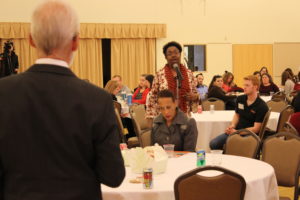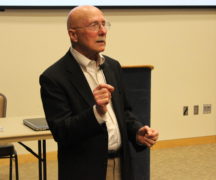By DAVID DUPONT
BG Independent News
Vincent Tinto left the best news for the end of his keynote address Monday at Bowling Green State University’s Teaching and Learning Fair.
“You don’t need new initiatives,” he told the luncheon crowd in the student union ballroom. “You have enough of them.” And they seem to be working. “I’m very impressed with the directions you’re taking.”
Tinto, a professor emeritus from Syracuse University who is considered a leading scholar in how to keep students in college, prefaced this good news with a review of approaches to help students succeed. To anyone paying attention to curriculum developments on campus, much did seem familiar.

Eileen Cherry-Chandler, of the Theatre and Film faculty, asks Vincent Tinto a question.
Supporting students means engaging them in the classroom, giving them a sense of belonging, setting high expectations and then assessing what’s working, Tinto said.
He reviewed strategies to do all this. For example, he said, “we hear again and again and again, that students do better in groups than they do on their own.”
Tinto continued: “The thing that drives learning in the classroom is active engagement with others in the classroom…. That drives a sense of belonging in the classroom.”
That learning can come in many flavors – collaborative, cooperative, problem-based or project-based. All, he said, use the student’s interest in making social connections in order to get them more involved in their learning.
Those groups, though, must be structured by the teachers. Letting students select who they work with often leads to one person doing most of the work.
The more students work together, the more they will study. “Active engagement with others predicts time on task,” he says. And time on task, studying, predicts academic success.
Tinto also noted: “You have service learning to which I say ‘Amen!’ … We’re producing citizens not workers.”
While institutions worry how they can retain students – in Ohio state funding depends on it – “students don’t want to retain. Students want to persist and complete even if it means having to transfer. The question you have to ask yourself is how do I act in ways that students want to stay and finish successfully? … How do we drive their motivation, that sense that they can succeed, and that sense of belonging. How do we get students want to learn?
“It’s not just teaching, folks,” Tinto said. “It’s constructing a classroom that has expectations, support, assessment, and engagement built into it.”
All this takes time. A new approach may take three years to really take hold in a course. In an institution it may take longer. State institutions, however, face constant demands from state officials to show steady progress every year. But progress is not a straight line pointed upward, Tinto said. It’s an “S” curve. The financial investment may come at the beginning but the results may not be immediately evident.
“Don’t be impatient,” Tinto concluded. “It’s going to take time.”





